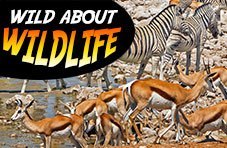Occupying the southern tip of the African Continent, South Africa presents one of the world’s natural gems. An incredible diversity of landscapes makes this country an ideal home for thousands of animal species, including exciting predators, mammals and reptiles.
When talking about South African wild animals roaming the grounds, what inevitably comes to everyone’s mind is the Big Five. If you remember, we’ve already written about the five most difficult animals to hunt on foot in Africa - African lion, African elephant, Cape buffalo, African leopard and rhino. The danger and difficulty involved in catching them have unfortunately made these 5 impressive creatures poachers’ lusted-after pray. However, with intensified measures put in place to protect them, the Big Five are more and more stars of wildlife safari experiences rather than valuable trophies or chunks of ivory sold for small fortunes.
Critically Endangered and Endangered Mammals
South Africa is also home to about 230 mammal species you can catch site of on a game drive or safari. Two of them are critically endangered - De Winton’s Golden Mole and the Riverine Rabbit, both endemic to this country. The first can be found only on coastal dunes and sandy areas in Strandveld of the Namaqualand coastal plain in the Northern Cape Province. Also known as Bushman’s hare, the Riverine Rabbit population counts as little as a few hundred living adults hopping across the central Karoo Desert of the Northern and Western Cape.
There are 11 more endangered species here, including the Mountain Zebra and African Wild Dog. Mountain Zebra can be found in high areas of the Western and Eastern Cape provinces, as well as the drier mountainous regions of Namibia. It consists of two sub-species, Hartman's Mountain Zebra, and small Cape Mountain Zebra. The latter almost became extinct in 1930’s due to hunting pressure but was luckily saved by the Mountain Zebra National Park, a reserve established specifically for their protection. The African Wild Dog, also known as a painted wolf, is native to Sub-Saharan Africa. This highly social animal which lives in packs demonstrates an unusual behaviour for a carnivore; it’s their females and not the males that leave the pack once sexually mature, and their young are allowed to be the first to feed on carcasses.
Other endemic mammals include the Cape Grysbok, Cape Elephant Shrew, Bontebok, Cape Mole-rat, Cape Kudu and Springbok. Cape Mole-rats live in excavated burrow systems ranging from 50 to 130 meters in length, which is where they forage for plant roots and store them for hard times in deep storage chambers. Elegant Cape Kudu boasts impressive long horns shaped like a cork screw, which sadly makes it a popular hunting trophy. Cape Elephant Shrew, populating rocky areas, got their name thanks to the long noses resembling the trunk of an elephant. These opossum-like, hopping little creatures which weigh less than half a kilo, are one of the fastest small mammals, with the highest recorded speed of almost 30 km/h. Gracious Cape Grysbok is a small antelope which can be spotted mainly during the night between Albany and the Cederberg mountains in the Western Cape region. Finally, there is the Springbok, whose name we proudly carry. This beautiful long-legged antelope is known for pronking – performing leaps up to 2 meters high, with stiff, straight legs and arched back.
Endemic South African Reptiles
South African reptiles are yet another contributor to the country’s biodiversity. Critically endangered Geometric Tortoise defends against the enemies with an extremely strong shell featuring a black and yellow pattern. These shy little tortoises will grow only to about 15cm in diameter, and apparently spend the months of June through September in hibernation. Their even smaller relative, Speckled Padloper, is recognised by a shell covered in hundreds of black spots and five toes on the fore feet. When courting, male and female nod heads at each other, and after 100 to 120 days, tiny babies will hatch out of eggs buried in damp soil between the rocks.
The Southern Adder is a small viper with a broad, triangular head. They’re able to grasp using their tail, and have also been seen climbing as high as 2 meters up the trees. Giant Girdled Lizard is the largest lizard species in Sub-Saharan Africa. It’s endemic to Highveld grasslands where the Adder lives in burrows excavated in the silty grassland soil. Cape Legless Skink is also a kind of lizard but with no limbs, known for burying its tube-shaped body in dry sand and under the boulders and dead trees.




